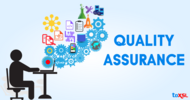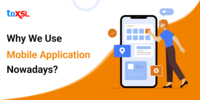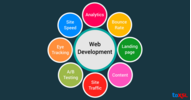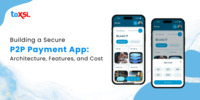- Apr 29, 2025
Share this post on:
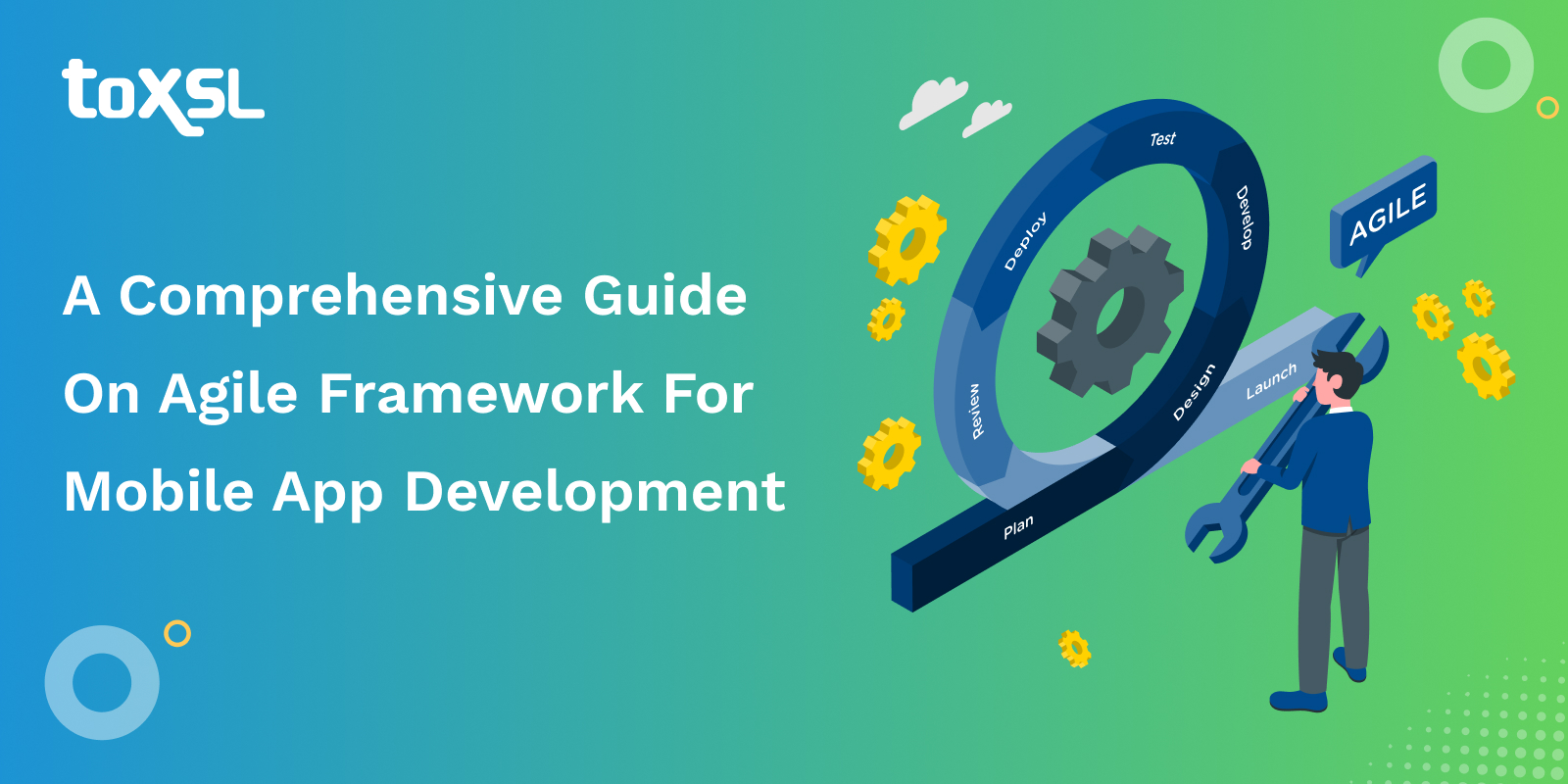
Mobile app development is a process of developing apps for various mobile devices. This field has grown rapidly over recent years due to advancements in technology and increased accessibility to internet connectivity.
In today's digital era, having a strong online presence through mobile apps is crucial for businesses and organizations to stay ahead of their competition. With that, more people are turning to their smart devices to perform tasks such as shopping, banking, communication, and more. This makes it crucial for companies to have a reliable and user-friendly app that meets the needs of the customers.
Mobile app development involves not only technical expertise but creative thinking as well. Developers must be able to create unique and engaging experiences that resonate with users. There are numerous s apps available for download across multiple platforms, the key challenge facing developers is standing out from the crowd and offering valuable apps to users. One of the best ways to develop mobile apps is Agile Framework.
Understanding Agile Framework
An agile framework allows teams to respond quickly to changes, deliver high-quality products faster, and continuously improve their processes along the way. By adopting an agile mindset, organizations can increase efficiency, innovation, and customer satisfaction while developing cutting-edge mobile applications.
Four Values of Agile Framework
The four values of the Agile Framework are as follows:
Individual and Interactions over Processes and Tools: One of the core values of the Agile framework focuses on "Individuals and Interactions" rather than relying on processes and tools. Here are some reasons why prioritizing individual contributions and collaboration holds immense value during projects:
1. Unique perspectives drive innovation: People bring distinctive knowledge, abilities, and viewpoints to the table, fostering creative solutions. This diversity promotes adaptability and problem-solving, allowing the team to excel beyond conventional boundaries.
2. Personal connections facilitate communication: When teams form tight bonds, they develop efficient channels for conveying ideas and addressing challenges. Strong interpersonal relationships enable smooth feedback loops, ensuring obstacles are resolved.
3. Shared understanding via active participation: By frequently interacting with colleagues, team members gain better insight into common objectives. This helps in building a sense of unity around common visions and goals. This helps avoid miscommunications and misunderstandings between roles and disciplines.
4. Focus on collaboration improves morale and motivation: Collaborative settings promote employee engagement by creating opportunities for skill development, idea exchange, and social support. This helps in encouraging a sense of collective accomplishment, leading to improved performance overall.
Working Software Over Comprehensive Documentation: Another crucial aspect of the Agile framework's set of core values focuses on producing working software instead of comprehensive documentation. Let us explore several advantages to this shift toward practical results over excessive planning papers:
1. Aligned Priorities: Software that delivers value often aligns team priorities with customer expectations. The objective becomes creating something solid that addresses user needs, keeping everyone focused on outcomes rather than generating documents.
2. Risk Mitigation: Since completed features have progress milestones and a robust testing process that assures quality control. Frequent releases, accompanied by user validation make it easier to rectify problems quickly without incurring rework costs.
3. Motivated Team: Teams work best when they have clearly defined targets to achieve. Focusing on deliverables keeps everyone engaged and accountable.
Customer Collaboration Over Contract Negotiation: A key value within the Agile framework is collaborating closely with customers versus following strictly the contract obligations. Although written agreements remain crucial, Agile emphasizes the importance of evolving these terms together as the relationship deepens and the project advances. Let us explore the benefits of dynamic collaboration with clients over fixed arrangements:
1. Dynamic Adaptability: Agile embraces changes in requirements and priorities by regularly reviewing agreements and shaping them accordingly.
2. Mutually Beneficial Outcomes: Jointly defining goals empowers both sides to identify the most valuable aspects of the project. This partnership approach encourages shared success criteria, enabling vendors and clients to achieve their desired business impact jointly.
3. Trustworthy Relationships: Regular interactions that involve transparency regarding product progress, potential roadblocks, and alternative options encourage strong bonding between vendor and customer. Building lasting connections reduces uncertainty, enhances collaboration, and promotes long-term success.
Responding To Change Over Following A Plan: In today’s fast-paced digital world, change has become an essential part of any successful business. The Agile framework places great emphasis on adapting to change effectively, rather than blindly following a predetermined plan. Here are six reasons why responding to change is vital in the agile world:
1. Embracing Uncertainty: The Agile mindset prepares organizations to handle unexpected developments with flexibility and resilience. Instead of sticking to a static strategy, Agile methods focus on being responsive.
2. Promoting Iterative Processes: Agility encourages ongoing refinement via continuous feedback loops between developers, stakeholders, and end-users. Constant fine-tuning means that even as priorities evolve, the resulting products will reflect the latest requirements and needs, maximizing efficiency and effectiveness.
Agile Project Management Process
To keep pace with today's rapid evolution of technology and market conditions, businesses have to frequently encounter unforeseen challenges during software development projects. Agile project management offers the necessary flexibility to iterate and refine processes dynamically. Let us dive into the fundamental steps involved in managing agile projects.

Planning Stage: In the Agile mobile app development process, the planning phase encompasses various aspects of defining a project's scope, objectives, timeline, budget, resources, and communication channels. At this stage, the goal is to identify the key elements needed to bring your mobile app vision to reality.
Development Stage: The development stage is where the actual creation of your mobile application takes place. During this phase of Agile app development, teams implement individual User Stories from the product backlog, continually refining their output until each feature meets the desired level of quality.
Testing Stage: Testing plays a crucial role in the overall Agile mobile app development process because it helps uncover issues before releasing new builds to end users. Successful testing involves creating strategies to address multiple types of tests, establishing clear expectations, setting relevant acceptance criteria, and employing test case templates.
Review Stage: Reviewing stage is another vital aspect of the Agile mobile app development process. This allows team members and stakeholders to inspect, discuss, and iterate over delivered outcomes to ensure alignment with project goals and quality standards.
Popular Agile Project Management Methodologies
Nowadays, Agile methodologies are gaining attraction as a preferred approach to managing projects. These methods are flexible and enhance collaboration and improvement to meet ever-evolving requirements and deliver maximum value to customers. Let us delve into the most prominent methodologies:
Scrum: Scrum is one of several popular agile project management methodologies. It focuses on iterative progress, frequent collaboration, and adaptability to changing requirements throughout development cycles.
Lean: Lean project management methodologies are iterative and incremental approaches that emphasize flexibility, efficiency, collaboration, and continuous improvement. These methodologies aim to streamline processes, reduce waste, and increase customer value by incorporating feedback loops, rapid prototyping, and cross-functional teamwork.
Kanban: Kanban is a visual scheduling system for managing workflows in agile projects. The main principle behind Kanban is to limit work-in-progress (WIP) to improve focus, reduce bottlenecks, and facilitate the flow of work items through a set process. This makes it ideal for complex, unpredictable environments where change and adaptation are necessary for success. Overall, Kanban can enhance productivity, quality, and employee morale in dynamic project settings.
A Few Benefits of Agile Framework for Mobile App Development
In a fast-paced world, businesses need to keep up with emerging trends and changing demands if they want to remain competitive. Traditional software development methods often struggle to adapt to changes effectively, leading many experts to turn towards Agile Methodologies instead.
Agile is all about adaptability and collaboration, two principles that play a critical role in ensuring project success and meeting business objectives.
Moving further in this article let us discusses some of the biggest benefits that Agile brings to mobile development projects. From greater flexibility to improved team performance and enhanced product quality, you will discover why Agile is increasingly becoming the go-to approach for mobile teams around the globe.
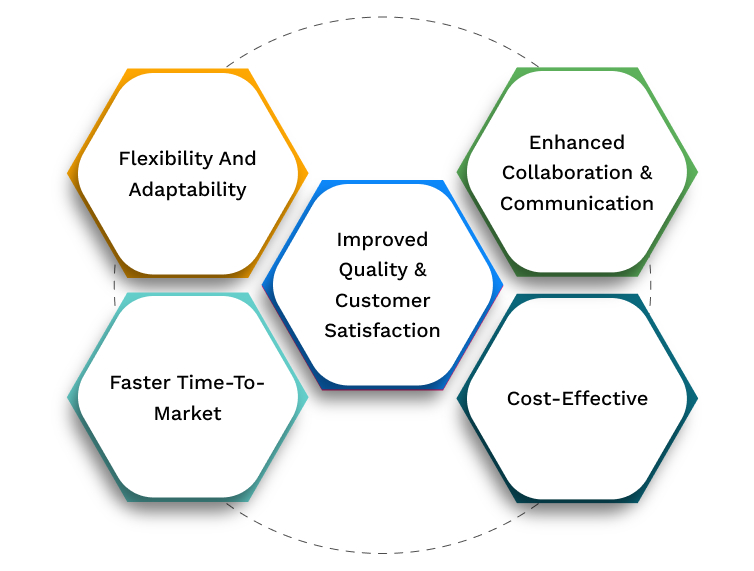
Flexibility and Adaptability: One of the key advantages of the Agile framework in mobile app development is its flexibility and adaptability. Agile allows for continuous feedback and iteration throughout the development process. The project is divided into smaller sprints, where developers work on specific features or functionalities. At the end of each sprint, stakeholders provide feedback, which can be incorporated into subsequent sprints. This iterative approach enables developers to adapt to changing requirements or market conditions quickly.
Faster Time-to-Market: In today's highly competitive app market, speed is crucial. Businesses need to launch their apps quickly to gain a competitive edge and capture market share. Agile methodology helps accelerate the time-to-market by breaking down the development process into smaller sprints.
Each sprint focuses on delivering a specific set of features or functionalities within a short timeframe. This allows developers to prioritize essential features and release them incrementally. Businesses can gather user feedback and make improvements based on real-world usage, by releasing a minimum viable product (MVP). This iterative approach not only reduces the time required for development but also ensures that the final product meets user expectations.
Enhanced Collaboration and Communication: Effective collaboration and communication are vital for the success of any mobile app development project. Agile methodology promotes cross-functional teams and encourages collaboration between developers, designers, testers, and stakeholders.
Daily stand-up meetings, known as scrums, are an integral part of Agile methodology. These short meetings allow team members to discuss progress, challenges, and plans for the day. Agile ensures that any issues or roadblocks are addressed promptly. Moreover, Agile methodology encourages regular interaction with stakeholders throughout the development process. Stakeholders have the opportunity to provide feedback at the end of each sprint, ensuring that their requirements are fulfilled.
Improved Quality and Customer Satisfaction: Quality is a critical factor in mobile app development. Users expect apps to be bug-free, responsive, and user-friendly. Agile methodology focuses on delivering high-quality products by incorporating testing and quality assurance throughout the development process.
In Agile, testing is not limited to the end of the project but is an ongoing activity throughout each sprint. Developers work closely with testers to identify and fix bugs early on. Testing early reduces the chances of major issues in the final product. This iterative testing approach ensures that the app is thoroughly tested before release.
Cost-effective: Cost efficiency is another significant benefit of the Agile framework for mobile app development. Agile allows businesses to allocate resources more efficiently by breaking down the project into smaller sprints. They can prioritize features based on their importance and allocate resources accordingly. This ensures that resources are not wasted on unnecessary or low-priority tasks. Moreover, Agile methodology reduces the risk of costly rework. Businesses can avoid major redesigns or redevelopments by incorporating feedback and making iterative improvements throughout the development process.
Conclusion:
In summary, Agile methodologies hold lots of potential benefits for mobile application development. These include increased responsiveness to changing requirements, improved alignment between customer expectations and final output, better productivity, and quick time-to-market.
Moreover, Agile empowers cross-functional teams to work closely together and solve complex problems. This leads to higher motivation and commitment levels among team members, resulting in exceptional software and satisfied clients.
If you are looking to develop your mobile apps using agile frameworks, ToXSL is here for you. We have a team of well-versed developers who have helped companies across the globe to grow. To know more, contact us.
FAQ's
What is the Agile framework in mobile app development?
Agile is a flexible and step-by-step process for building mobile apps. It breaks the project into small tasks called sprints, allowing faster development and quick changes. At ToXSL Technologies, we use Agile to build apps efficiently, keep clients involved, and deliver features regularly without delays.
Why is Agile better than traditional app development methods?
Agile allows regular updates, client feedback, and quick adjustments. Unlike traditional methods, you don’t wait until the end to see results. At ToXSL Technologies, Agile helps us identify issues early, stay on schedule, and build high-quality apps that truly match the client’s needs from start to finish.
How does Agile improve communication during mobile app development?
Agile encourages regular meetings between developers and clients. This ensures everyone is on the same page and any changes can be made immediately. At ToXSL Technologies, we keep you updated throughout the process, listen to your feedback, and make improvements quickly, resulting in better teamwork and a successful app.
Can Agile help deliver mobile apps faster?
Yes, Agile speeds up development by dividing work into small, manageable parts. Each part is completed, tested, and shared quickly. At ToXSL Technologies, we use Agile to deliver working versions of your app faster, saving time and allowing you to launch quicker in the market with fewer risks.




